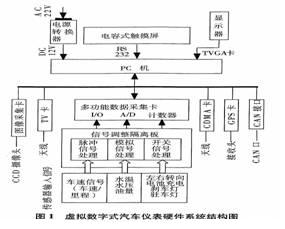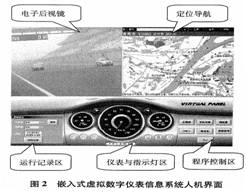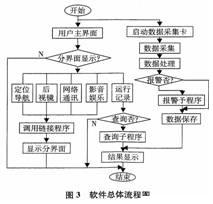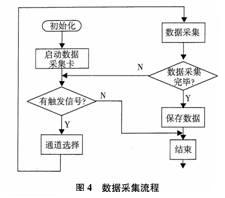Automotive instrumentation is the window for information exchange between cars and drivers, and is also a major part of automotive high-end technology. Countries have been working hard to develop automotive instrumentation technology and continue to make new progress. Automotive instrumentation is gradually developing towards digitalization and intelligence. Replacing the electrical or electronic instruments commonly used in China at this stage with digital virtual instruments has become an important issue in vehicle automation. The virtual digital instrument information system independently developed by the author has been successfully installed on the Aspire pure electric concept car developed by the School of Automotive Engineering of Wuhan University of Technology for real vehicle testing. Based on this, the vehicle's positioning navigation and rear view are realized. Photography, network communication, audio-visual entertainment and car black box. This model is an application example of virtual digital automobile instrument. This paper gives the hardware structure, man-machine interface and software implementation based on LabVIEW of virtual digital automobile instrument information system.
This article refers to the address: http://
First, the key technology of virtual digital automobile instrument information system
The virtual digital automobile instrument information system is an intelligent system that integrates various automotive electronic technologies, including intelligent instrumentation systems, vehicle navigation systems, fault diagnosis systems, and vehicle black box subsystems. It is a hot spot in the automotive industry of various countries.
(1) Data acquisition technology
In addition to the data such as gyroscopes and odometers used for navigation, in order to make the driver understand the condition of the vehicle, it is necessary to collect data reflecting the vehicle performance parameters such as the car spindle speed, tire pressure and temperature. The way the car data acquisition module can be used depends on the actual situation.
(2) GSM communication technology
To realize the intelligence of the vehicle, a network communication function must be established on the vehicle. The choice of communication network is key, which determines the capacity, reliability, and coverage of the information center monitoring coverage. The realization of communication technology can realize wireless communication, mobile office and online surfing of vehicles.
(3) Data dump module
The status information, position information, speed information and load of each major equipment of the vehicle are important information for judging the cause of the accident. It is necessary to save the historical data before parking. To facilitate the output of the data, a non-contact IC card or a mobile hard disk USB is used. Storing data. This is what the car black box needs to achieve.
(4) Display technology of virtual digital instruments
The amount of information of the virtual digital meter is very large. If the display method of the traditional meter is used, the number of instruments on the vehicle will increase, making the dashboard of the vehicle appear crowded, and the operation difficulty of the driver will be increased, and the driver's operation will be dispersed. attention. The on-board virtual digital instrument built with virtual instrument technology solves these problems. It combines all the information displays on one screen and displays them in an interface. This will make it easy for the driver to view the information, cancel the numerous instruments, and make the interior space more spacious, comfortable and beautiful.
Second, the hardware composition and man-machine interface of virtual digital automobile instrument information system
(1) Hardware composition of virtual digital automobile instrument information system
The selection and combination principle of the system hardware is: fully consider the compatibility and cost performance of each hardware; fully consider the electromagnetic compatibility of the system, ensure that the system can work normally under the harsh electromagnetic environment; meet the basic functional requirements of the system, and fully consider The system is scalable and streamlined, with a number of extensible interfaces reserved.
The information system consists of a PC, peripheral hardware devices, an operating system, and a user application. The peripheral hardware equipment is mainly composed of liquid crystal display, touch screen, digital I/0 data acquisition card, wheel speed sensor, battery monitoring system, CCD camera, TV card, GPS receiver and wireless network card, etc., virtual digital car instrument hardware system structure As shown in Figure 1. 
(2) Man-machine interface of virtual digital automobile instrument information system
The virtual digital vehicle instrument information system integrates virtual technology and digital technology, and has various functions such as virtual instrument, electronic rearview mirror, fault monitoring, operation record, GPS vehicle positioning, multimedia audio and video, Internet communication and mobile office. The function interface is shown in Figure 2.

1. Instrument and indicator area
The meter and indicator area displays the speedometer, battery charge status table, battery temperature gauge, lighting and signal indicator, alarm signal indicator and gear indicator. When the vehicle speed exceeds a certain speed, an overspeed voice prompt will be issued.
2. Running record area
The operation log area displays the one-way odometer with reset button, cumulative odometer, date and time, and log button. The one-way odometer shows the mileage of a single trip. Pressing the clear button will reset the one-way odometer to zero; the accumulated odometer will display the total mileage of the car; press the record button to display the speed, mileage, fault and vehicle running of the car. Alarm history (car black box function).
3. Program control area
The program control area displays the operation buttons of the following programs: electronic rear view, car navigation, Internet browser, MP3 player, wireless TV and FM radio.
4. Electronic rear view area
The electronic rear view area displays the rear image of the car taken by the camera to facilitate the driver to observe the traffic situation behind the car.
5. Positioning navigation
The positioning navigation area displays an electronic map, which uses the car positioning information received by the GPS receiver to depict the running track of the car on the electronic map. The positioning navigation program provides static navigation and can determine the shortest driving route according to the starting and ending names provided by the driver.
Third, the virtual digital vehicle instrument information system software implementation
The performance of the entire system In addition to the need for a stable and high-performance hardware platform, software plays a vital role. The various functions and combinations of the system, the representation of the human-machine interface, etc. are all done by software.
This system uses LabVIEW, an intuitive graphical programming language, to establish a front panel man-machine interface and block diagram in a very intuitive way to complete the programming process. The front panel is visible to the user, similar to the traditional instrument panel, using the tool template to add input controllers and output indicators from the control template, controller and indicator types are selectable. The block diagram is the core that supports virtual instruments to implement their functions. The design of the block diagram involves the design of nodes, data ports, and wires. Connections represent data trends, and nodes are functions, VI subroutines, structures, or code interfaces.
The overall flow chart of the software design of the virtual digital vehicle instrument information system is shown in Figure 3.

The content of the virtual digital automobile instrument information system is very rich. In order to make the interface of the instrument clear, beautiful and comfortable, the content of the vehicle information system is divided into different interfaces according to the characteristics of the display information and the frequency of the driver's demand.
The display operation of the virtual digital car instrument interface is realized by a touch screen. You can switch to the interface you want to view by touching the soft button of the corresponding function on the main interface with your finger. The interface display of the virtual digital car instrument information system is shown in Figure 2. The realization of the specific functions of the virtual digital automobile instrument is completed by software, and the software mainly performs the following functions. 
(1) Driving and initializing each function board in the computer
1. Data acquisition card driver
The various types of data acquisition cards produced by National Instruments are very convenient to use. Before writing the VI, you only need to set the relevant parameters under LabVIEW's “Measurement & Automation†driver software.
2. Data acquisition parameter initial setting
In order for the data acquisition card to correctly implement the data acquisition function, some parameters must be set according to the actual measurement needs. The parameters to be set mainly include the device number and address code of the capture card, in addition to the setting items of the analog signal input part, the setting items of the A/D conversion part, the setting items of the D/A conversion part, and the settings of the DIO and the counter part. item.
(2) Converting and processing various sensor signals
The data acquisition and processing will collect the analog voltage signal or pulse signal and switch signal converted by the sensor to the corresponding channel of the data acquisition card, and perform digital filtering, format conversion, equivalent calculation and unit conversion, etc., and convert the data into directly The data displayed on the display.
The data processing part is relatively simple, and data acquisition is the key to software programming. The data acquisition signals have analog quantity, switch digital quantity and pulse digital quantity. The overall process of data acquisition is shown in Figure 4.
(3) Implementation of positioning navigation
1. Positioning navigation driver
Since the navigation module is an outsourced integrated board, the manufacturer provides a driver library written in C, C++, and BASIC. How to call it in the LabVIEW environment is a problem that needs to be solved by using an outsourced product.
LabVIEW solves this kind of problem in several ways, such as direct port I/O mode, calling CLF node and calling CIN node. CIN mode is used here. CIN is a general method for calling C source code in LabVIEW. C language is currently recognized as a powerful program language. LabVIEW can greatly expand its overall function by interfacing with C language.
CIN is a function node located in the LabVIEW block diagram program window. On the function template Advanced sub-template, you can implement the C language source code in LabVIEW. The user can compile the external code to be called into a format that LabVIEW can recognize and connect to this node. When this node is executed, LabVIEW will automatically call the external code connected to this node and pass the specific data structure to CIN. Since the storage format of data in LabVIEW follows the storage format of data in C language, and the two are identical, using CIN can achieve higher program efficiency. The CIN node needs to call the file in .lsb format. The CINTools compiled by LabVIEW can compile the Visual C++ source code into the .lsb format that the CIN node can recognize.
The driving methods of other purchased modules (cameras, communication cards, TV cards, etc.) are all performed in this way.
2. Positioning navigation interface
The electronic map software is included when the GPS device is purchased. After installing and using the LabVIEW link, click the navigation soft key in the main interface of the virtual digital car instrument information system to invoke the GPS navigation interface.
(4) Implementation of rear view camera and network communication
The rear view camera and network communication module are outsourced modules, and the outsourced module manufacturers provide the C source code driver. We only need to call it in the LabVIEW environment and link the software.
(5) Realization of audio-visual entertainment
The audio and video entertainment section includes TV and MP3. The TV is an outsourced TV module, and its implementation method is similar to the positioning navigation driver call, and the MP3 is realized by calling the playing software.
(6) The realization of the function of the car black box
The virtual digital automobile instrument realizes the function of the car driving recorder-black box through software, which is also the advantage of the system compared with the traditional instrument system.
Car black boxes need to record data such as the state of motion of the vehicle, the operating state of critical safety components, and the driver's operating behavior during the last period of a dangerous accident. In the accident handling phase, this information will be used to partially or completely reproduce the process of the accident, analyze and determine the cause of the accident, which requires the data to be stored and queried. Virtual instrument software designed with LabVIEW enables data storage and data query functions.
Data storage: Save the sampled data to a file, which can be saved as a text file or a spreadsheet file. It can also be saved as a file in the form of a dynamic data record unique to LabVIEW. The file of the dynamic data record can only be opened in this system.
Data Query: Reads a previously saved data record file.
Fourth, the conclusion
The virtual digital instrument has been tested by many real vehicles, which proves that the system is safe and reliable, and the display data can meet the actual driving needs in accuracy.
In summary, the application of the virtual digital automobile instrument makes the reading of the instrument clearer and more intuitive, the information volume is larger, the intelligence is higher, the power consumption is low, and the development cycle is short, which is relatively expensive compared with the conventional vehicle equipment. Advantages, therefore have broad application prospects. Of course, this field is still in its infancy in China. There is still a lot of work to be done in the real practical stage, but as the technology matures, it will have a far-reaching impact on the automotive industry.
Universal Extension Socket,Universal Plug,Multifunction Socket
Normal Size PSU(S Series),Constant Voltage( SMV series) Co., Ltd. , http://www.chpower-supply.com